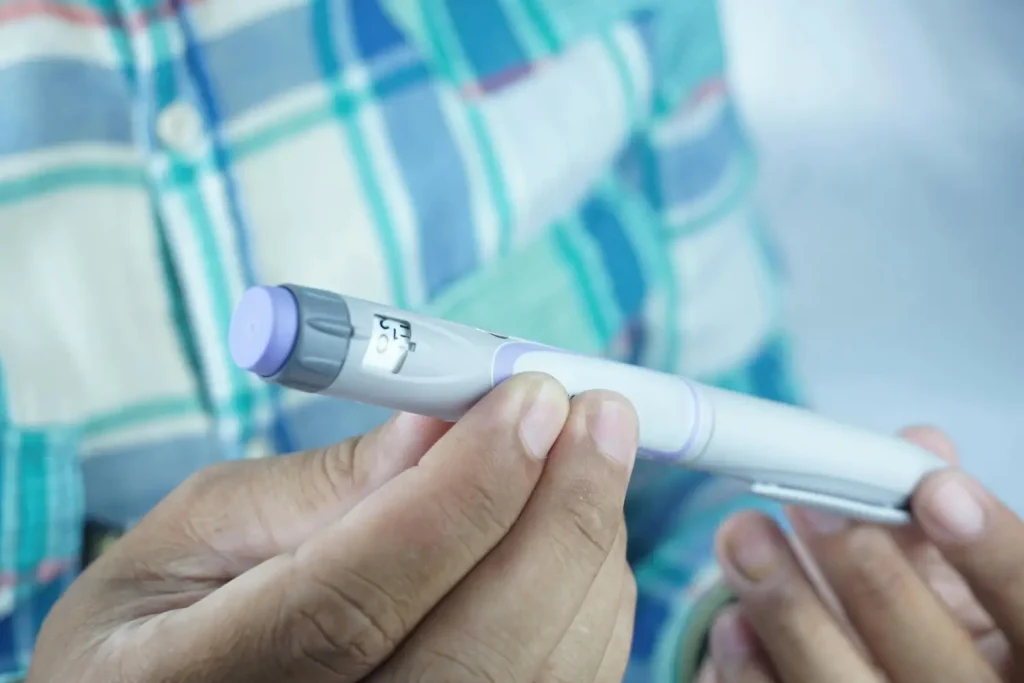When starting injectable therapies, the way a medication is dosed can significantly impact a patient’s experience, often making the difference between successful treatment and early discontinuation. Rapid dose escalation can lead to common gastrointestinal side effects like nausea, bloating, and diarrhea, which may affect adherence. Thankfully, these risks can be minimized through careful titration.
This is especially true for Mounjaro (tirzepatide), a once-weekly injectable approved for type 2 diabetes and weight management. Its dosing protocol begins with a low dose, gradually increasing over time to give the body a chance to adjust and reduce side effects.
In this article, we’ll explore Mounjaro’s dosing schedule, titration strategies, and clinical considerations to help ensure safe and effective use.
Key Takeaways
- Mounjaro (tirzepatide) starts with an initiation dose of 2.5 mg once weekly, gradually escalating to higher doses.
- The titration process helps minimize gastrointestinal side effects such as nausea, vomiting, and diarrhea, enhancing patient adherence and long-term success.
- The maintenance dosing typically ranges from 5 mg to 15 mg once weekly, with dose escalation based on glycemic control, patient tolerance, and overall treatment goals.
- Mounjaro’s dosing schedule is designed to provide gradual adjustments, minimizing risks and ensuring safe, effective treatment.
- Regular monitoring of glucose levels, side effects, and contraindications ensures patient safety and supports optimal therapeutic outcomes.
About: Medical Spa RX provides medical practices with premium products at the best prices. If you’re looking to buy Mounjaro online for your practice, the sales representatives at Medical Spa RX can give you guidance.
Approved Dosing Schedule for Mounjaro: Initiation and Titration
The Mounjaro initiation dose begins at 2.5 mg once weekly, administered subcutaneously. This initial dose is meant only for starting the treatment, not for long-term glycemic control. After four weeks, the dose increases to 5 mg once weekly, which serves as the first maintenance level. From there, the dose may be increased by 2.5 mg every four weeks based on patient response and tolerance.
When discussing comparisons of incretin therapies such as Mounjaro vs Ozempic, Mounjaro allows for more gradual dose escalation and offers a broader range of doses, helping clinicians tailor treatment to individual needs. This stepwise approach supports more effective glucose and weight management, while minimizing side effects that may affect treatment adherence.

This gradual titration process allows the body to adjust to the medication, reducing common gastrointestinal effects such as nausea, vomiting, and diarrhea. The slower increase also gives clinicians a chance to assess patient tolerance before increasing the dose, ensuring both efficacy and safety as patients move toward the maintenance phase that aligns with their treatment goals.
Maintenance Dosing Range and Dose Escalation Parameters
Once titration is complete, Mounjaro’s maintenance dosing typically ranges from 5 mg to 15 mg once weekly. The optimal maintenance dose depends on several factors, including glycemic control, patient tolerance, and overall treatment goals. Dose escalation follows these key parameters:
- Incremental Increases: The dose can increase by 2.5 mg every four weeks if more glycemic improvement is needed.
- Maximum Dose: Do not exceed 15 mg once weekly, as higher doses may increase the risk of side effects.
- Clinical Response Evaluation: Adjust the dose based on blood glucose readings, treatment goals, and the patient’s tolerance.
- No Abrupt Escalation: Gradual increases help minimize gastrointestinal intolerance and improve overall treatment adherence.
Administration Details: Route, Timing, and Missed Dose Protocol
Mounjaro is administered subcutaneously once a week using a prefilled pen device. Patients can inject it into the abdomen, thigh, or upper arm, rotating injection sites each week to minimize local irritation. The medication can be taken at any time of the day, with or without food, as long as patients administer the injection on the same day each week.

If a dose is missed, it should be administered as soon as possible within four days (96 hours) after the missed dose. If more than four days have passed, the patient should skip the missed dose and resume their regular schedule. Patients should never inject two doses within three days of each other.
Proper administration technique, site rotation, and consistent scheduling are key to maintaining stable drug levels and maximizing treatment efficacy. Healthcare providers should ensure that patients fully understand how to use the pen device and store it properly for safe at-home administration.
Monitoring During Dosing: Glucose Control, Side Effects, Contraindications
Effective monitoring during Mounjaro therapy is critical for ensuring patient safety, optimizing glycemic outcomes, and identifying potential adverse effects early. Regular follow-up visits enable healthcare providers to adjust therapy based on clinical response, tolerance, and any comorbid conditions.
Glucose Control
- Self-monitoring: Regular blood glucose checks during dose escalation help assess therapeutic response and prevent hypoglycemia.
- HbA1c testing every three months offers a comprehensive view of long-term glycemic control, helping guide future dose adjustments.
- Patients taking other glucose-lowering agents, like insulin or sulfonylureas, may need dose adjustments to maintain stable blood sugar levels.
Side Effects
- Common side effects include nausea, vomiting, diarrhea, and reduced appetite, particularly during the titration phase.
- Serious adverse effects such as pancreatitis, gallbladder disease, or hypersensitivity reactions should be closely monitored.
- Patient education on recognizing symptoms and maintaining adequate hydration can help manage gastrointestinal issues effectively.
Contraindications and Precautions
- Mounjaro should not be used in patients with a personal or family history of medullary thyroid carcinoma or Multiple Endocrine Neoplasia syndrome type 2 (MEN 2).
- Caution is advised for patients with gastroparesis or severe gastrointestinal disorders, as slower gastric emptying can worsen symptoms.
Consistent monitoring ensures therapeutic success, minimizes complications, and promotes safe, long-term management of type 2 diabetes.
Special Populations and Safety Considerations in Dose Planning
When prescribing Mounjaro, clinicians should consider individual patient factors that may affect dosing and tolerance.
- Elderly Patients: There is no required specific dose adjustment, but older adults may need slower titration to manage side effects.
- Renal or Hepatic Impairment: Limited data are available, so closely monitor renal and hepatic function and adjust the dose if intolerance symptoms arise.
- Pregnant or Breastfeeding Women: There is insufficient human data on tirzepatide during pregnancy. Use only in this population if the potential benefit justifies the potential risk. Discontinue if planning pregnancy and consult a healthcare provider.
- Patients with Gastroparesis or GI Disorders: Slower gastric emptying may worsen symptoms. If intolerance persists, a healthcare practitioner may consider alternative therapies.
- Concurrent Medications: Drugs that affect glucose control (e.g., insulin or sulfonylureas) may need adjustments to prevent hypoglycemia.
Individualized dosing is crucial to ensure the best possible outcomes for each patient. Clinical assessment, patient education, and regular reviews are essential for safe and effective dose planning.
Conclusion
Mounjaro is an effective therapy for managing type 2 diabetes and supporting weight loss when used under proper supervision. Its initiation and titration phases are designed to help patients build tolerance and achieve stable glycemic control with minimal side effects. Understanding the Mounjaro dose schedule, including maintenance levels, escalation intervals, and injection timing, is crucial for safe, consistent results.
Regular monitoring of glucose levels, side effects, and contraindications enhances patient safety and allows for timely adjustments. Dose adjustments should always be individualized, particularly in older adults or patients with organ impairment. By following an evidence-based titration and monitoring plan, healthcare providers can maximize treatment benefits while minimizing risks.
Mounjaro’s structured dosing strategy underscores the importance of gradual adjustment and personalized care in diabetes management.
FAQs
1. What is the starting dose of Mounjaro?
The initiation dose of Mounjaro is 2.5 mg once weekly, for four weeks before increasing to 5 mg.
2. How often can my dose increase?
Every 4 weeks by 2.5 mg increments. However, this depends on tolerance and glycemic response.
3. What should I do if I miss a Mounjaro injection?
Take the missed dose within four days; if more time has passed, skip it and resume the next scheduled injection.
4. Can I use Mounjaro with other diabetes medications?
Yes, but doses of insulin or sulfonylureas may need adjustment to prevent hypoglycemia. Always consult your clinician.
5. What is the maximum dose of Mounjaro?
The maximum recommended maintenance dose is 15 mg once weekly, individualized based on treatment goals and patient tolerance.
References
Tyson RJ, Park CC, Powell JR, et al. Precision dosing Priority criteria: drug, disease, and patient population variables. Frontiers in Pharmacology. 2020;11. doi:10.3389/fphar.2020.00420
Mounjaro: Uses, Dosage, Side Effects & Warnings. Drugs.com. https://www.drugs.com/mounjaro.html





















